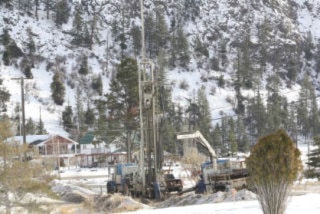Jim Howe of Aqua Source Well Drilling has been drilling wells in the Twin Lakes aquifer as well as in the Willowbrook basin for 12 years.
As far as experience goes, Howe may be one of the most reliable sources around, given the near complete lack of any documentation regarding aquifers in these areas. Howe is becoming increasingly concerned about the future viability of these aquifers, based on the knowledge he has accumulated in the past dozen years.
“In Willowbrook, old well logs indicate that most drilling was done only into the upper zone - there used to be good water 40 feet down,” he told the Review in late December.
“That whole zone doesn’t exist today - we have to drill 100 to 120 feet to hit anything.”
Howe explained that the alluvial formations making up the aquifer are so tight at that depth that old water channels have to be tapped into in order to find any water.
“It’s a ‘holding body’ now - not a real aquifer.” Howe’s last well drilled at Willowbrook was completed near the firehall - at a depth of 110 to 120 feet.
“The old well logs talked of using two inch standpipe 40 feet into the ground, that used to work well. Those are non-existent today.”
Howe has also done some drilling in the aquifer just north of Keremeos, in the area around the graveyard on Liddicoat Road.
“It’s a very fragile aquifer, too,” he said. “There is one property in that area where the well goes dry when a neighbouring rancher turns his irrigation on. I’ve drilled two wells in that area and hit bedrock before hitting the aquifer.”
Howe speaks even more critically of the Twin Lakes aquifer, referring to it as an “ongoing mess.”
“You can tell what’s going on there by the lake level - you can see where high water used to be,” he said, although he admits the water table in Twin Lake is higher than it was three years ago.
“ I drilled four wells on the east side of the lake in September of 2007 - the lake was way down then,” he noted.
“Twin Lake is a small, confined aquifer with a small recharge zone - it’s a water issue that involves the development within the community and the golf course itself.”
When asked what he thought was going on with respect to the aquifers in these areas, Howe commented that water tables are cyclical, usually replenishing themselves naturally - something that is not indicated by what he has witnessed. “I think a lot of it (declining levels) are man made,” he said.
Howe feels local government should be taking steps to limit development, at the same time as they monitor community wells
“Cut back on the number of lots,” he said, “ and subdivide minimum half acre lots for starters.” He also noted that there was no solution that would be immediate in nature.
“This is an ongoing problem,” he said in conclusion, “but something needs to be done. After all, water is the most important thing we have.”
